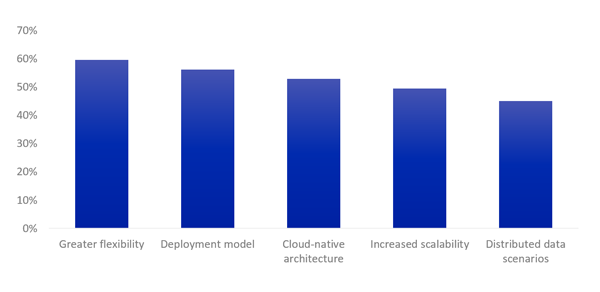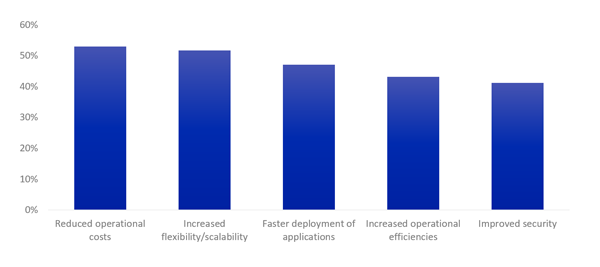SAP Workloads Are Moving to the Cloud
Secure Data is Critical
by Robert Holland, VP & Research Director, SAPinsider
We have seen an increase in the number of organizations that are running at least some solutions in the cloud since 2019, when we began tracking cloud trends occurring in the SAPinsider Community. While research in previous years has revealed that the number of enterprise workloads in the cloud has been increasing, our 2021 research focuses on how SAP workloads are being impacted by this trend. What we found is that 88% of SAPinsiders are running at least some of their SAP workloads in a private, public, or hybrid cloud environment. Of the 12% who are running all their SAP workloads on internal infrastructure, or in a managed environment on-premise, nearly two-thirds say that they plan to move those workloads to the cloud within two years.
The business drivers behind the move towards cloud-based infrastructure remain largely the same as they did in 2020. What has changed is that there is now a much greater focus on ensuring that any data moved to the cloud is secure. This is combined with a need to manage the ROI and costs that are involved with moving data away from traditional on-premise environments.
Explore related questions
Which SAP Workloads are Moving to the Cloud?
Our research shows that workloads most likely to be running on either internal infrastructure or a managed environment-on premise are: manufacturing solutions; older enterprise ERP solutions like SAP ECC or SAP Business Suite; data warehousing solutions like SAP Business Warehouse; planning solutions; and financial solutions. In each instance at least 40% of the survey respondents were running these workloads in on-premise infrastructure.
Workloads most likely to be running in a private or hybrid private cloud environment are travel solutions, likely SAP Concur running in an SAP managed environment, and customer relationship management (CRM) solutions. More than half of the respondents using these solutions said that they were running them in some form of private cloud. Solutions that were also likely to be running in private cloud environments included the SAP Business Technology Platform (BTP), probably in SAP HANA Enterprise Cloud; SAP S/4HANA; procurement solutions; supply chain solutions; and SAP HANA.
When looking at the public or hybrid public cloud, the workloads that were most likely to be running in that environment were SAP S/4HANA, with 49% of respondents running the solution indicating that it was running in a public cloud environment; HR solutions like SAP SuccessFactors; procurement solutions like SAP Ariba; the SAP BTP; and e-commerce solutions. Apart from SAP S/4HANA, between 40% and 43% of respondents running these workloads said that they were likely to be running in a public cloud environment.
Unsurprisingly, no respondents using travel solutions, procurement solutions, e-commerce solutions, or RISE with SAP were running these workloads on internal infrastructure. However, a third of those using e-commerce solutions said that they were running them in managed environments on-premise, and a quarter of those using procurement solutions said that same thing. This would most likely be SAP HANA Enterprise Cloud but might also be a storage-as-a-service offering from one of SAP’s large hardware partners.
Why are SAP Workloads Moving to the Cloud?
In choosing to move SAP workloads to the cloud, the primary goal that most organizations want to achieve is greater flexibility (see Figure 1). Slightly less than two thirds (60%) of respondents indicated that this was a factor behind moving SAP workloads to the cloud, which corresponds with the fact that 52% of respondents said they plan to measure the success of their cloud initiatives by looking at whether they have achieved increased flexibility and scalability.

Figure 1 Which Factors Are Part of Your Decision to Move SAP Workloads to the Cloud?
Also highlighted in Figure 1 is that organizations are looking for a way in which they can leverage the cloud deployment model. This is very important because according to the same research, the main business driver behind moving to the cloud is “business focus on digital transformation requires cloud-based deployments.” The cloud deployment model — especially the ability to be able to pilot and deploy applications more quickly — is also one of the top ways in which organizations will measure success. In all, 47% of survey respondents said that faster deployment of applications was a measurement they would use to determine project success (Figure 2).

Figure 2 How Will You Measure the Success of Your Cloud Initiatives?
The cloud deployment model also plays into the fact that 75% of respondents said they expect the cloud can resolve their high availability (HA) issues. Some are looking to achieve this by using a hybrid deployment model (both hybrid private cloud and hybrid public cloud deployment models were popular among survey respondents). Others may be using multiple cloud providers to achieve their HA goals, as demonstrated by our finding that most respondents who were using a public cloud provider for their SAP workloads tended to be using more than one. Some may be running different solutions on different providers, while others may be running a development or test system on one provider and running production on a second provider. Either way, cloud deployment models coupled with cloud-native architecture are very important reasons for organizations to choose the cloud.
It’s notable that the top criterion for measuring the success of their cloud initiatives, according to respondents, is reduced costs. Respondents are also measuring flexibility and scalability, whether they are able to deploy applications more quickly, whether there is an increase in operational efficiencies, and whether security improves. These measurement criteria were also important for organizations when selecting a cloud service provider. The top three criteria used by respondents when making this choice were service level agreements (SLAs), data center locations, and security.
Protecting Vital Data
Beyond the business drivers that are pushing organizations toward cloud-based infrastructure and the actions that they are taking to address these drivers, respondents have requirements that they must meet. The two most important of those requirements are a plan for cloud-based data encryption and protection (85%), and data storage and protection requirements (79%) (see Figure 3). This directly connects to the fact that the need to protect access to sensitive and confidential data was the number one driver behind the SAPinsider Community’s current cybersecurity efforts. With more and more organizations reporting cybersecurity and ransomware attacks, or responding to credentials being compromised within the organization, it is no surprise that securing data in every environment is critical. And particularly in the cloud.

Figure 3 Top Requirements for Cloud Deployment
While these security-focused requirements were important in our previous research, there was a near 20% increase in the number of respondents who said that having a plan for cloud-based data encryption and protection was important or very important to their cloud deployment strategy when compared to 2020. This moved the requirement from fourth in 2020 to first on the list in 2021. Similarly, data storage and protection requirements also saw an increase in the number of respondents selecting it. While the increase was only a small one year over year, this still made data storage and protection requirements the second most important requirement for respondents.
Managing Costs
A new requirement facing organizations that were not on the list in 2020 but were the third most important in 2021 was that of comprehensive cloud cost management and planning. Selected by 78% of respondents as being important or very important to their cloud deployment strategy, this supports the strategy of creating an ROI, cost, and risk model for the cloud and makes it clear that organizations are concerned about managing the cost of their cloud initiatives.
While a shift to cloud-based infrastructure can offer an immediate benefit to organizations that are looking to implement new solutions without the need for significant capital expenditure on internal infrastructure, the operational expenditure can add up over time. This can be especially true when cloud systems can be spun up quickly, often without the direct involvement of IT teams. Putting in place comprehensive cost management and planning can provide the guidelines that will help ensure that costs do not exceed plans, allowing organizations to experience the benefits of the cloud without as many concerns about cost overruns.
A Measured Move to the Cloud
This data reveals that organizations are taking a more measured approach to cloud deployment. Unlike 2020 when many companies saw the need to move enterprise workloads to the cloud as quickly as possible to support new business environments, today they are looking to understand and manage cost and ensure that their data is secure as they perform that move. For some workloads, this will be within the next year, but for other workloads, the move to the cloud is up to two years away as organizations plan their moves more thoroughly.
For analytics and business intelligence (BI), HR, and even SAP ECC, the greatest proportion of respondents plan to move these solutions within the next year. For e-commerce, procurement, CRM solutions, and planning workloads, most respondents said that the move is planned for the next two years. This likely reflects that not only is the workload moving to the cloud, but a new solution may be implemented at the same time which requires more planning. This is different from SAP ECC, for example, where the move to the cloud may be a more straightforward lift and shift.
What Does This Mean for SAPinsiders?
Implement a plan for securing cloud-based applications before you start deployment. One of the most important steps that you can take with any move to the cloud is to put a security plan in place before rolling out any applications. Not only will this ensure that your data is properly secured with your cloud services provider, your connectivity channels are secured, and you understand how integrations with other solutions will be managed; it also has the potential to accelerate your cloud deployments. If these plans are not in place, you can waste significant time by needing to come back and address security challenges, delaying what may be a time-sensitive rollout. Get your security plans in place first to prevent interruption.
Understand how you will plan and manage the cost of your cloud deployments. Many organizations rushed to implement cloud-based solutions without fully understanding what the cost of running those applications over an extended period would be. Setting up a plan for comprehensive cloud cost management will help control the cost of your cloud deployments, but it will also help you achieve expense goals that are an important part of a move to the cloud. Doing this as part of a broader ROI, cost, and risk model that involves working with cloud providers to understand charges, ensuring that internal teams cannot roll out cloud-based systems without approval, and rolling out guidelines for cloud usage will help ensure that you meet the cost-related measurements for cloud success.
Use a measured approach when moving to the cloud. The benefits of the cloud are significant. They include increased flexibility and scalability, the ability to deploy applications quickly, and the fact that cloud-based solutions can provide new and improved functionality. But SAPinsiders should ensure that they understand what benefits cloud-based deployments will bring, as well as how they will manage costs and security, before beginning a project. A measured approach upfront will put in place the requirements for success in the long term and offers the potential to eliminate risks that could result from moving in haste.








